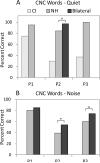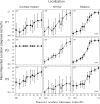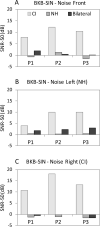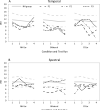Auditory abilities after cochlear implantation in adults with unilateral deafness: a pilot study
- PMID: 22935813
- PMCID: PMC3603694
- DOI: 10.1097/MAO.0b013e318268d52d
Auditory abilities after cochlear implantation in adults with unilateral deafness: a pilot study
Abstract
Objective: This pilot study examined speech recognition, localization, temporal and spectral discrimination, and subjective reports of cochlear implant (CI) recipients with unilateral deafness.
Study design: Three adult male participants with short-term unilateral deafness (<5 yr) participated. All had sudden onset of severe-to-profound hearing loss in 1 ear, which then received a CI, and normal or near normal hearing in the other ear. Speech recognition in quiet and noise, localization, discrimination of temporal and spectral cues, and a subjective questionnaire were obtained over several days. Listening conditions were CI, normal hearing (NH) ear, and bilaterally (CI and NH).
Results: All participants had open-set speech recognition and excellent audibility (250-6,000 Hz) with the CI. Localization improved bilaterally compared with the NH ear alone. Word recognition in noise was significantly better bilaterally than with the NH ear for 2 participants. Sentence recognition in various noise conditions did not show significant bilateral improvement; however, the CI did not hinder performance in noise even when noise was toward the CI side. The addition of the CI improved temporal difference discrimination for 2 participants and spectral difference discrimination for all participants. Participants wore the CI full time, and subjective reports were positive.
Conclusion: Overall, the CI recipients with unilateral deafness obtained open-set speech recognition, improved localization, improved word recognition in noise, and improved perception of their ability to hear in everyday life. A larger study is warranted to further quantify the benefits and limitations of cochlear implantation in individuals with unilateral deafness.
Figures







References
-
- Roland JT, Shapiro WH, Waltzman SB. Cochlear implantation as a treatment option for single-sided deafness: speech perception benefit. Audio Neurotol. 2011;16(suppl 1):8–9.
-
- Arndt S, Aschendorff A, Laszig R, et al. Comparison of pseudobinaural hearing to real binaural hearing rehabilitation after cochlear implantation in patients with unilateral deafness and tinnitus. Otol Neurotol. 2011;32:39–47. - PubMed
-
- Ramos A, Moreno C, Falcon JC, et al. Cochlear implantation in patients with sudden unilateral sensorineural hearing loss and associated tinnitus. Audio Neurotol. 2011;16(suppl 1):10–11.
-
- Punte AK, Vermeire K, Hofkens A, et al. Cochlear implantation as a durable tinnitus treatment in single-sided deafness. Cochlear Implants Int. 2011;12:S1–S29. - PubMed
-
- Buechner A, Brendel M, Lesinski-Schiedat A, et al. Cochlear implantation in unilateral deaf subjects associated with ipsilateral tinnitus. Otol Neurotol. 2010;31:1381–1385. - PubMed
Publication types
MeSH terms
Grants and funding
LinkOut - more resources
Full Text Sources
Medical

